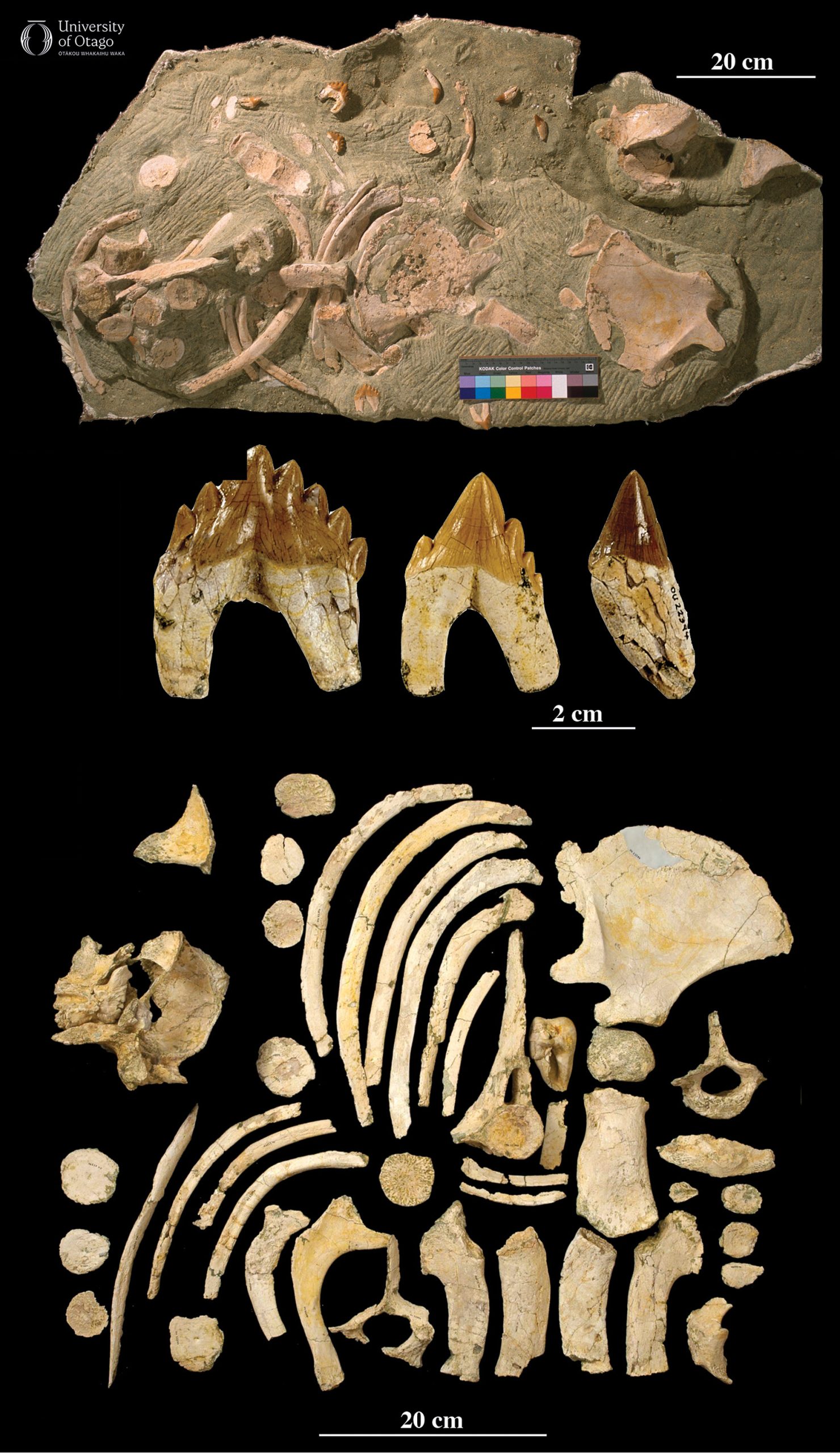21 Last of the ancient whales: final salute to the old guard
Cetacea, Kekenodontidae: Tohoraonepu nihokaiwaiu
Whales first appeared along the shores of the Tethys Ocean in what is now modern-day India and Pakistan around 49 million years ago. As whales began to spread outwards across global oceans they diversified into new lineages. One of these lineages would give rise to today’s baleen whales and toothed whales (including dolphins and porpoises). This lineage was named the ‘new whales’ (Neoceti) by Ewan Fordyce and Christian de Muizon. Whales in every other lineage would all become extinct over time, and have been grouped together under the name ‘ancient whales’ (Archaeoceti). The extinction of the last species in each of the ancient whale lineages occurred at a different period in the deep past. For a moment in time, however, species in the last of the ancient whale lineages were living alongside the earliest species of the new whale lineages. This last ancient whale lineage is named the Kekenodontidae. Fossils from Kekenodontidae discovered in Aotearoa New Zealand were the focus of Joshua Corrie’s doctorate research at the University of Otago.

Bones from the archaic whale Tohoraonepu nihokaiwaiu (specimen OU 22394). By studying the worn enamel on the teeth shown here, researchers have discovered that Tohoraonepu nihokaiwaiu was a predator. Image source: Figure 3 in J Corrie, and RE Fordyce (2024) A new genus and species of kekenodontid from the late Oligocene of New Zealand with comments on the evolution of tooth displacement in Cetacea, which is licensed under CC BY-NC-ND 4.0. Image credit: RE Fordyce. |
Just two species representing Kekenodontidae have been described so far. Fossils from the first species in this lineage were discovered in 1880 in North Otago by Alexander McKay. James Hector described these fossils in 1881 and determined that they belonged to a species that was new to science, Kekenodon onamata. Fossils from the second species were also discovered in North Otago more than 100 years later and were described in 2024 by Joshua Corrie and Ewan Fordyce. The second species was named Tohoraonepu nihokaiwaiu. Two other fossils have been proposed to belong to the same Kekenodontidae lineage of ancient whales, but these specimens have yet to be formally identified.
Tohoraonepu nihokaiwaiu lived between 27.3 and 25.2 million years ago during a span of time known locally as the Duntroonian Stage. At approximately 2.5 metres in length, Tohoraonepu nihokaiwaiu was a similar size to the largest of the common dolphins Delphinus delphis living today. However, the fossil bones that were named Tohoraonepu nihokaiwaiu were from a young individual, and when it was fully grown it may have reached up to four metres long, closer in size to a large bottlenose dolphin Tursiops truncatus.
The name Tohoraonepu means sand whale and the origin of the name is from Te Reo Māori, where tohorā is whale and onepū is sand. In Te Reo Māori, niho kai waiū refers to baby teeth, which gives the species name for this ancient whale.
Kekenodon onamata and Tohoraonepu nihokaiwaiu shared the oceans with the ancestors of today’s dolphins but do not themselves have descendants living today. Together, these kekenodontids probably had a similar ecology to living toothed whales by hunting other marine mammals, seabirds and large fish. Eventually the last species in the Kekenodontidae lineage became extinct, leaving the descendants of the ‘new whales’ to inherit the oceans.
—Written by Daniel B Thomas
| Specimen number: OU 22394 | Age: Approximately 26 million years old (late Oligocene, Duntroonian stage) |
| Locality: Awamoko Valley, North Otago | Rock Formation: Kokoamu Greensand |
| Collected by: RE Fordyce, A Grebneff | |
| Citation: Corrie J, Fordyce RE. 2024. A new genus and species of Kekenodontid from the late Oligocene of New Zealand with comments on the evolution of tooth displacement in Cetacea. Journal of the Royal Society of New Zealand 54:722–737. doi.org/10.1080/03036758.2023.2297696 | |
A group of marine mammals with around 90 living species across two key clades, Mysticeti (baleen whales) and Odontoceti (toothed whales, including dolphins and porpoises). The fossils of many extinct species of cetacean have been discovered.
An ancient precursor to the modern Indian Ocean, the Mediterranean Sea, and the Black Sea and Caspian Sea.
Marine mammals within Cetacea that have large keratin plates (baleen) for filtering food from water. One of two major clades within Neoceti, with the other being Odontoceti. Living examples include blue whale (Balaenoptera musculus) and southern right whale (Eubalaena australis).
Marine mammals within Cetacea that have teeth. One of two major clades within Neoceti, with the other being Mysticeti. Living examples include sperm whale (Physeter macrocephalus) and Hector's dolphin (Cephalorhynchus hectori).
All living species within Cetacea and the descendants of their most recent shared ancestor, including extinct species.
Ancient close relatives of living whale and dolphin species. In taxonomic terms, 'archaeocetes' are all species within Cetacea that are not within Neoceti.
Evidence of life from a past geological age. Remains like bones, shells or wood, or an impression like a footprint, or some other evidence of life, from something that was alive more than 11,700 years ago.
27.3 to 25.2 million years ago.
A mammal that is dependent on offshore marine environments for finding food.
A bird that is dependent on offshore marine environments for finding food.

